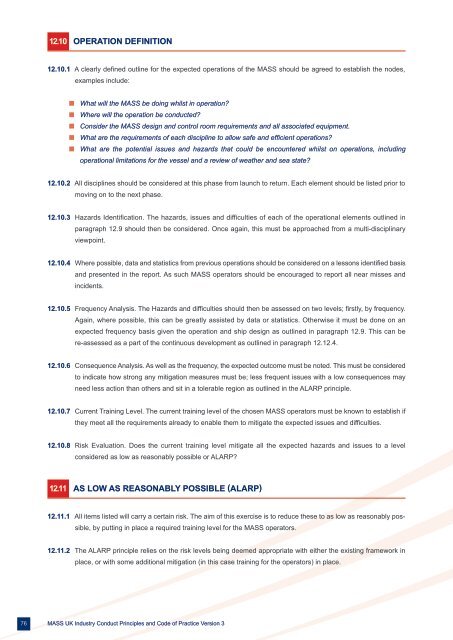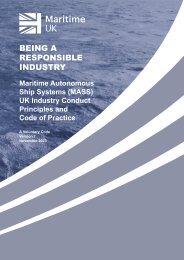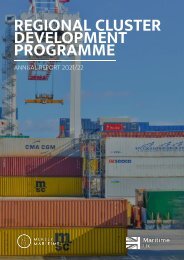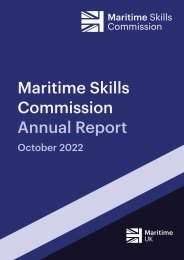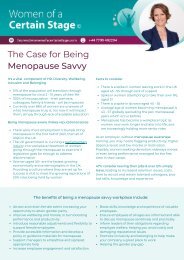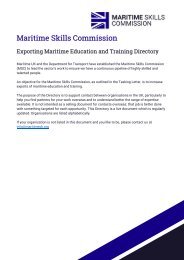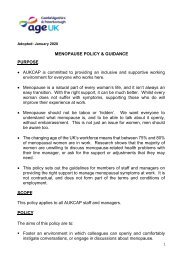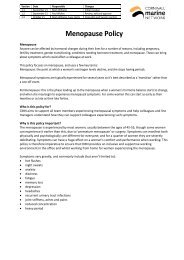code_of_practice_V3_2019
Create successful ePaper yourself
Turn your PDF publications into a flip-book with our unique Google optimized e-Paper software.
12.10 OPERATION DEFINITION<br />
12.10.1 A clearly defined outline for the expected operations <strong>of</strong> the MASS should be agreed to establish the nodes,<br />
examples include:<br />
n What will the MASS be doing whilst in operation?<br />
n Where will the operation be conducted?<br />
n Consider the MASS design and control room requirements and all associated equipment.<br />
n What are the requirements <strong>of</strong> each discipline to allow safe and efficient operations?<br />
n What are the potential issues and hazards that could be encountered whilst on operations, including<br />
operational limitations for the vessel and a review <strong>of</strong> weather and sea state?<br />
12.10.2 All disciplines should be considered at this phase from launch to return. Each element should be listed prior to<br />
moving on to the next phase.<br />
12.10.3 Hazards Identification. The hazards, issues and difficulties <strong>of</strong> each <strong>of</strong> the operational elements outlined in<br />
paragraph 12.9 should then be considered. Once again, this must be approached from a multi-disciplinary<br />
viewpoint.<br />
12.10.4 Where possible, data and statistics from previous operations should be considered on a lessons identified basis<br />
and presented in the report. As such MASS operators should be encouraged to report all near misses and<br />
incidents.<br />
12.10.5 Frequency Analysis. The Hazards and difficulties should then be assessed on two levels; firstly, by frequency.<br />
Again, where possible, this can be greatly assisted by data or statistics. Otherwise it must be done on an<br />
expected frequency basis given the operation and ship design as outlined in paragraph 12.9. This can be<br />
re-assessed as a part <strong>of</strong> the continuous development as outlined in paragraph 12.12.4.<br />
12.10.6 Consequence Analysis. As well as the frequency, the expected outcome must be noted. This must be considered<br />
to indicate how strong any mitigation measures must be; less frequent issues with a low consequences may<br />
need less action than others and sit in a tolerable region as outlined in the ALARP principle.<br />
12.10.7 Current Training Level. The current training level <strong>of</strong> the chosen MASS operators must be known to establish if<br />
they meet all the requirements already to enable them to mitigate the expected issues and difficulties.<br />
12.10.8 Risk Evaluation. Does the current training level mitigate all the expected hazards and issues to a level<br />
considered as low as reasonably possible or ALARP?<br />
12.11 AS LOW AS REASONABLY POSSIBLE (ALARP)<br />
12.11.1 All items listed will carry a certain risk. The aim <strong>of</strong> this exercise is to reduce these to as low as reasonably possible,<br />
by putting in place a required training level for the MASS operators.<br />
12.11.2 The ALARP principle relies on the risk levels being deemed appropriate with either the existing framework in<br />
place, or with some additional mitigation (in this case training for the operators) in place.<br />
76<br />
MASS UK Industry Conduct Principles and Code <strong>of</strong> Practice Version 3


